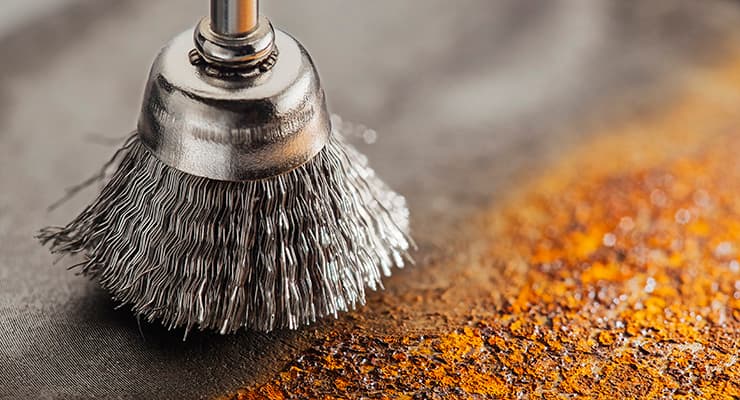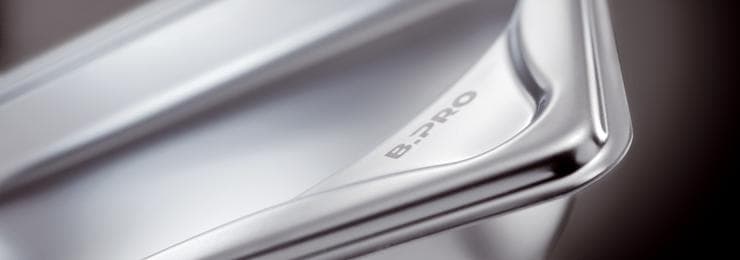
Not all steel is the same: a little material science
An exciting question: Can ‘stainless steel’ rust? Before we take a closer look, let's first clarify a few key terms. It's an incredible number, but the term steel covers over 5,000 types of steel, which can have completely different properties due to their different compositions. Here is a rough definition:
Steel
is a material with iron as its main component and a carbon content of less than 2.06 per cent. Steel can be cold or hot formed, i.e. it can be forged, bent, rolled or drawn. Iron-carbon alloys with a carbon content of over 2.06 per cent are known as cast iron.
Stainless steel
is a particularly pure steel. In addition to iron, steel always contains quantities of undesirable phosphorus and sulphur (so-called iron by-products).
These elements have a negative effect on the utilisation properties. A steel may therefore only be labelled as stainless steel if sulphur and phosphorus make up less than 0.025% by mass in the alloy.
(Alloy = mixture of at least one metal and one or more other chemical elements)
Stainless steel
refers to stainless steel whose alloy contains more than 10.5 per cent chromium.
Due to the high chromium content, a protective layer of chromium oxide forms on the surface of the material (so-called passive layer). This layer prevents the oxygen in the air from reacting with the iron in the steel - which would cause the steel to rust. This is because rust occurs when the iron in the steel reacts with oxygen and water. Chemically speaking, rust is oxidised iron. Rust is porous and rusty areas promote further corrosion of the metal until it completely disintegrates. This is precisely what the passive layer of chromium oxide protects ‘stainless steel’ from.

Protective layer with self-healing power
Since ‘stainless steel’ has this dense chromium oxide protective layer, it cannot rust - or can it? The protective layer of chromium oxide is ‘self-healing’.
This means that if the protective layer is damaged at one point, for example by mechanical impact, a new protective layer immediately forms again at this point, as the chromium from the steel automatically combines with the air to form chromium oxide (= protective layer = passive layer).
Self-healing requires cleanliness and oxygen
A self-renewing protective layer - that sounds great. However, there is a small catch: the chromium oxide protective layer can only form and remain intact on a clean surface. Continuous contamination from environmental influences - such as exhaust fumes, soot particles, table salt or chloride-containing liquids - can damage the protective layer. And then real rust can form (corrosion) even on ‘stainless steel’. Regular cleaning of the surfaces is therefore essential to ensure that the self-healing power of the passive layer can function reliably.
Practical tip: Empty and clean the stainless steel container regularly!
This is because oxygen is needed to form the protective passive layer. However, if there is always water in bain-marie wells, for example, corrosion can occur - there is no contact with oxygen from the air, which is necessary for the formation of the passive layer.
Good to know:
For ‘stainless steel’ to corrode, it usually takes some time and poor conditions. If you discover brown rust deposits on stainless steel, these are fortunately rarely a sign of real corrosion. It is usually just rust particles from the environment that have settled on the workpiece above the protective layer - so-called rust film. Flash rust can be easily removed from the surface by cleaning.
Conclusion: Under certain poor conditions, even ‘stainless steel’ can rust. Therefore, clean the surfaces regularly with a suitable agent - and corrosion has no chance.
Can stainless steel rust? The material consultant from thyssenkrupp
 Eye-catcher with added value
Eye-catcher with added valueA customised look for catering products brings real benefits for managers and guests. Whether colour accents, decors or logos, B.PRO offers a wide range of options for personalising food serving counters and other equipment.
 Company restaurant with a feel-good atmosphere
Company restaurant with a feel-good atmosphereThe modernisation of the Bühler company restaurant and snack bar at its site in Leobendorf, Austria is already yielding tangible results among employees. B.PRO contributed solutions for modern food serving.
 Expertise from one single source
Expertise from one single sourceB.PRO supplies system solutions that have it all: They increase the attractiveness of the culinary offer and facilitate work processes. This holistic approach is also evident in project management.
